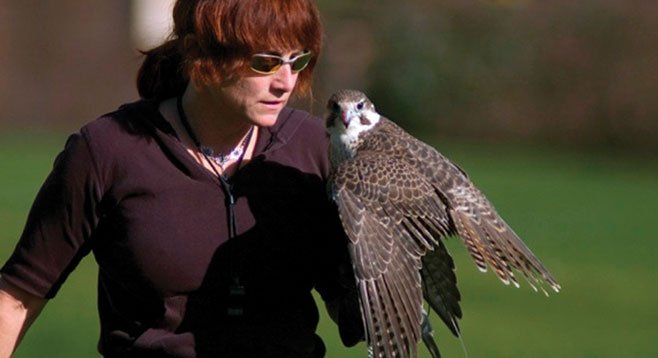 Facebook
Facebook
 X
X
 Instagram
Instagram
 TikTok
TikTok
 Youtube
Youtube

In the United States, our falconry, we’re not pet keepers, it’s a hunting sport... Kate Marden, master falconer.
Marden, 55, owns West Coast Falconry in Marysville, California. Onsite are a Barn Owl, Eurasian Eagle Owl, Swainson’s Hawk, several Harris Hawks, Peruvian Harris Hawk, Peregrine Falcon, Yellow Headed Vulture, and more. She is also a partner in West Coast Falconry–San Diego. The following is taken from one visit and two telephone interviews.
Marden says, “I was born in San Francisco. Moved around a lot when I was a kid, but for the most part I grew up in West Marin. You could go to a pet store and buy any parrot. I had macaws, cockatoos, cockatiels, conures, just about everything. It’s like having a psychotic two-year-old, especially with the macaws and cockatoos. They need affection, attention, a lot of game-playing and interaction. They live in the wild in huge flocks so they have constant stimulation. There’s always somebody to play with. If I’m playing with you and you get bored, well, I can turn over here and play with George. If he gets bored I can go over here and play with Sam. Constant stimulation. They relate to physical affection.
“Birds of prey don’t. They love to play some games, and you definitely want to keep their life enriched and stimulated, but they don’t require the emotional output parrots need. Most of my predators would be perfectly happy if I fed them and just left them alone. They don’t even care if they fly or not, because in the wild they’re only flying about 20 minutes a day. They’re predators. The rule for predators is the least amount of effort for the most gain.

“I did a lot of different things. I worked in auto parts, I did shipping and receiving, I did delivery driving, I worked on photocopy machines, and I started the first dog daycare center in San Rafael. In the ’90s I worked in a renaissance fair. A friend said, ‘They’re going to be doing a Falconry show and they need volunteers...’
“My job was to keep dogs away, and when the falconer threw his falcon I was a spotter. This older gentleman struck up a conversation with me. I told him I was volunteering and he pulled a card out of his back pocket and said, ‘My name is Earl Walton. I’m a master falconer, and if you’d ever like to become a real falconer just give me a call.’ That was 1996. I got my falconry license in 1998.
“I lived in Lagunitas, which is in the heart of the redwood forest and it’s just too damp for the birds. My sister and I raised my boy and then I moved up here in 2006. Land values around here, you get more bang for your buck, also access to hunting grounds, and, in my opinion, a more reasonable attitude about hunting.
“In order to become a falconer, you have to take a written test from the California Department of Fish and Wildlife. You also have to find another falconer with at least five years experience whose going to be your sponsor, your mentor. They’re going to be responsible for how you take care of your bird and they’re going to be monitoring that and also how you hunt with your bird. So, the first two years you’re an apprentice falconer working directly under the tutelage of a licensed falconer.
“You have a bird, but you’re limited to which birds you can have, which birds you can fly. In California you can have either a Red-tailed (hawk) or a Kestrel (falcon). They have to be a wild-caught bird. It’s like catching a baby dragon.
“As an apprentice you’re allowed to have one bird a year and if that bird dies you can get one replacement. First year, my bird died. I got a replacement, that bird died. The next year I got a bird, that bird died, I went through four birds in two years. They didn’t die from negligence on my part. Two of them died of aspergillosis, it’s like staff. It’s everywhere.
“After two years as an apprentice, you’re sponsor says, ‘Okay, you’ve done a good job,’ and signs your paperwork. Now you’re licensed as a general falconer for five years. After seven years accumulated time working with a bird of prey, then you’re called a master falconer.”
The U.S. Census Bureau estimates there are 38 million people living in California. According to the California Hawking Club there are about 700 falconers in-state.
Marden can be reached at westcoast-falconry.com or 530-749-0839. For West Coast Falconry–San Diego, call 619-722-0092 or stop by skyfalconry.com.


In the United States, our falconry, we’re not pet keepers, it’s a hunting sport... Kate Marden, master falconer.
Marden, 55, owns West Coast Falconry in Marysville, California. Onsite are a Barn Owl, Eurasian Eagle Owl, Swainson’s Hawk, several Harris Hawks, Peruvian Harris Hawk, Peregrine Falcon, Yellow Headed Vulture, and more. She is also a partner in West Coast Falconry–San Diego. The following is taken from one visit and two telephone interviews.
Marden says, “I was born in San Francisco. Moved around a lot when I was a kid, but for the most part I grew up in West Marin. You could go to a pet store and buy any parrot. I had macaws, cockatoos, cockatiels, conures, just about everything. It’s like having a psychotic two-year-old, especially with the macaws and cockatoos. They need affection, attention, a lot of game-playing and interaction. They live in the wild in huge flocks so they have constant stimulation. There’s always somebody to play with. If I’m playing with you and you get bored, well, I can turn over here and play with George. If he gets bored I can go over here and play with Sam. Constant stimulation. They relate to physical affection.
“Birds of prey don’t. They love to play some games, and you definitely want to keep their life enriched and stimulated, but they don’t require the emotional output parrots need. Most of my predators would be perfectly happy if I fed them and just left them alone. They don’t even care if they fly or not, because in the wild they’re only flying about 20 minutes a day. They’re predators. The rule for predators is the least amount of effort for the most gain.

“I did a lot of different things. I worked in auto parts, I did shipping and receiving, I did delivery driving, I worked on photocopy machines, and I started the first dog daycare center in San Rafael. In the ’90s I worked in a renaissance fair. A friend said, ‘They’re going to be doing a Falconry show and they need volunteers...’
“My job was to keep dogs away, and when the falconer threw his falcon I was a spotter. This older gentleman struck up a conversation with me. I told him I was volunteering and he pulled a card out of his back pocket and said, ‘My name is Earl Walton. I’m a master falconer, and if you’d ever like to become a real falconer just give me a call.’ That was 1996. I got my falconry license in 1998.
“I lived in Lagunitas, which is in the heart of the redwood forest and it’s just too damp for the birds. My sister and I raised my boy and then I moved up here in 2006. Land values around here, you get more bang for your buck, also access to hunting grounds, and, in my opinion, a more reasonable attitude about hunting.
“In order to become a falconer, you have to take a written test from the California Department of Fish and Wildlife. You also have to find another falconer with at least five years experience whose going to be your sponsor, your mentor. They’re going to be responsible for how you take care of your bird and they’re going to be monitoring that and also how you hunt with your bird. So, the first two years you’re an apprentice falconer working directly under the tutelage of a licensed falconer.
“You have a bird, but you’re limited to which birds you can have, which birds you can fly. In California you can have either a Red-tailed (hawk) or a Kestrel (falcon). They have to be a wild-caught bird. It’s like catching a baby dragon.
“As an apprentice you’re allowed to have one bird a year and if that bird dies you can get one replacement. First year, my bird died. I got a replacement, that bird died. The next year I got a bird, that bird died, I went through four birds in two years. They didn’t die from negligence on my part. Two of them died of aspergillosis, it’s like staff. It’s everywhere.
“After two years as an apprentice, you’re sponsor says, ‘Okay, you’ve done a good job,’ and signs your paperwork. Now you’re licensed as a general falconer for five years. After seven years accumulated time working with a bird of prey, then you’re called a master falconer.”
The U.S. Census Bureau estimates there are 38 million people living in California. According to the California Hawking Club there are about 700 falconers in-state.
Marden can be reached at westcoast-falconry.com or 530-749-0839. For West Coast Falconry–San Diego, call 619-722-0092 or stop by skyfalconry.com.
Comments